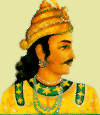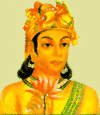The Military Conquests
of Chandragupta Maurya

The story of
the military conquests of Chandragupta Maurya begins with his coming to
power.
The Nandas were a people who had held a
territory in north-west India (called Magadha). There was a brahman, named
Kautila who had been cheated by the court of the Nandas people, who sought
revenge. He did by defaming the kings, the government, and the Nandas
people in general. Because he was not elligible for kingship himself (due
to physical deformality), he took a certain Chandragupta under his wing
and used him to lead a revolt against the Nandas people. Eventually, after
a failed attempt Kautilya and Chandragupta succeeded, and Chandragupta
was named king of Magadha around 320 BC.
About this time Alexander the Great had been
continuing his conquering of the Indian people all around north-west
India. Eventually his invasion was halted (through the complaining of
his troops of the endless land and hard fighting Indians). In 323 BCE,
he died, and his empire was split up amongst his military generals.
Chandragupta used this oppurtunity and drove
out all the Greeks in north-west India with the combined forces of his
own and the conquered Nandas army. He then proceeded to easily conquer
all the tribes around the area of north-west India. After which,
he conquered the peoples along the Ganges river, defeating its capital,
Paliputra, and making it his own. In 313 BCE he named himself ruler.
Seleuces Nicator, the Greek official in charge
of the the empire in Asia after the death of Alexander, attempted to
try to recapture the Indian land in 305 BCE. After losing (in about two
years), a treaty was set up between Maurya and Seleuces. In exchange for
500 elephants, Chandragupta recieved the Greeks claim in India and the Kabul Valley. This agreement was cemented with a
marriage (probably a Seleucid princess to a Mauryan prince). In addition,
Nicator sent an ambassador to Maurya named Megasthenes. His writings on
the court and life of the Mauryans became an important source for historians
in persuit to discover more about the Mauryan Empire.
Chandragupta kept up his empire until 301 BCE,
when he handed it over to his son, Bindusara. Legend has it that he became
a Jainist monk and starved himself to death eventually.
Of the three
first emperors, least is known about Bindusara. He ruled from around 300
BC to about 275 BC. He continued to expand his empire and army, much like
his father did. Eventually, Bindusara became sick, and there seemed to
be some panic as to who would take over the throne. Suddenly, one by one
many of the sons of Bindusara were killed, until there was only son left:
Ashoka, the only one who seemed to be able to evade death. Ashoka eventually
became historically the most well-known of the Mauryan empires, albeit
not for his militaristic power.

After an internal
struggle for power, Ashoka came to power around 272 BC. It took hime almost
a decade to secure his authority. He began his rule a harsh ruler, enforcing
his laws strictly and repressed his people greatly. After securing his
authority, he turned to a military conquest. He decided to annihiliate
those kingdoms the previous leaders had left alone. In particular, he chose
the kingdom of Kalinga, only because its borders blocked the Mauryan
Empire from a part of the Ganges river. In this invasion, he realized that
he was killing hundreds of thousands of ordinary people who had not deserved
it. He realized his brutality and suddently became Buddhist. His Buddhist
belief caused him to become a compassionate ruler for both his own people
and those people outside his territory. From then he used his great military
for no other reason then to keep up his empire internally and for defense.
After his death, the empire gradually fell apart. Thus, the beginning of
his Buddhist belief ends the military conquests of the Mauryan Empire.
